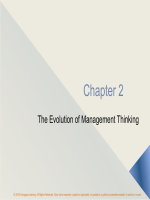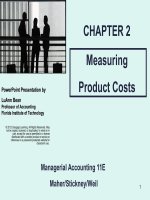Operation management 11e heizer render chapter 02
Bạn đang xem bản rút gọn của tài liệu. Xem và tải ngay bản đầy đủ của tài liệu tại đây (926.52 KB, 73 trang )
Operations Strategy in
a Global Environment
2
PowerPoint presentation to accompany
Heizer and Render
Operations Management, Eleventh Edition
Principles of Operations Management, Ninth Edition
PowerPoint slides by Jeff Heyl
© 2014
© 2014
Pearson
Pearson
Education,
Education,
Inc.Inc.
2-1
Outline
►
Global Company Profile: Boeing
►
A Global View of Operations
►
Developing Missions and Strategies
►
Achieving Competitive Advantage
Through Operations
►
Issues in Operations Strategy
© 2014 Pearson Education, Inc.
2-2
Outline – Continued
►
Strategy Development and
Implementation
►
Strategic Planning, Core
Competencies, and Outsourcing
►
Global Operations Strategy Options
© 2014 Pearson Education, Inc.
2-3
Learning Objectives
When you complete this chapter you
should be able to:
1. Define mission and strategy
2. Identify and explain three strategic
approaches to competitive advantage
3. Understand the significant key
success factors and core
competencies
© 2014 Pearson Education, Inc.
2-4
Learning Objectives
When you complete this chapter you
should be able to:
4. Use factor rating to evaluate both
country and provider outsources
5. Identify and explain four global
operations strategy options
© 2014 Pearson Education, Inc.
2-5
Boeing’s Global SupplyChain Strategy
Some of the International Suppliers of Boeing 787 Components
SUPPLIER
HEADQUARTERS
COUNTRY
COMPONENT
Latecoere
France
Passenger doors
Labinel
France
Wiring
Dassault
France
Design and PLM software
Messier-Bugatti
France
Electric brakes
Thales
France
Electrical power conversion
system and integrated
standby flight display
Messier-Dowty
France
Landing gear structure
Diehl
Germany
Interior lighting
© 2014
© 2014
Pearson
Pearson
Education,
Education,
Inc.Inc.
2-6
Boeing’s Global SupplyChain Strategy
Some of the International Suppliers of Boeing 787 Components
SUPPLIER
HEADQUARTERS
COUNTRY
COMPONENT
Cobham
UK
Fuel pumps and valves
Rolls-Royce
UK
Engines
Smiths Aerospace
UK
Central computer systems
BAE Systems
UK
Electronics
Alenia Aeronautica
Italy
Upper center fuselage and
horizontal stabilizers
Toray Industries
Japan
Carbon fiber for wing and tail
units
Fuji Heavy Industries
Japan
Center wing box
© 2014
© 2014
Pearson
Pearson
Education,
Education,
Inc.Inc.
2-7
Boeing’s Global SupplyChain Strategy
Some of the International Suppliers of Boeing 787 Components
SUPPLIER
HEADQUARTERS
COUNTRY
COMPONENT
Kawasaki Heavy
Industries
Japan
Forward fuselage, fixed
sections of wing, landing
gear wheel well
Teijin Seiki
Japan
Hydraulic actuators
Mitsubishi Heavy
Industries
Japan
Wing box
Chengdu Aircraft Group
China
Rudder
Hafei Aviation
China
Parts
Korean Airlines
South Korea
Wingtips
Saab
Sweden
Cargo and access doors
© 2014
© 2014
Pearson
Pearson
Education,
Education,
Inc.Inc.
2-8
Global Strategies
▶ Boeing – sales and supply chain are
worldwide
▶ Benetton – moves inventory to stores around
the world faster than its competition by
building flexibility into design, production, and
distribution
▶ Sony – purchases components from
suppliers in Thailand, Malaysia, and around
the world
© 2014 Pearson Education, Inc.
2-9
Global Strategies
▶ Volvo – considered a Swedish company,
recently purchased by a Chinese company,
Geely. The current Volvo S40 is assembled
in Belgium, South Africa, Malaysia and China
on a platform shared with the Mazda 3 built
in Japan and the Ford Focus built in Europe.
▶ Haier – A Chinese company, produces
compact refrigerators (it has one-third of the
US market) and wine cabinets (it has half of
the US market) in South Carolina
© 2014 Pearson Education, Inc.
2 - 10
Growth of World Trade
60 –
55 –
50 –
Percent
45 –
40 –
35 –
30 –
25 –
20 –
15 –
|
|
|
|
|
|
|
|
|
10 –
1970 1975 1980 1985 1990 1995 2000 2005 2010
Year
© 2014 Pearson Education, Inc.
Figure 2.1
2 - 11
Reasons to Globalize
1. Improve the supply chain
2. Reduce costs (labor, taxes, tariffs, etc.)
3. Improve operations
4. Understand markets
5. Improve products
6. Attract and retain global talent
© 2014 Pearson Education, Inc.
2 - 12
Improve the Supply Chain
▶ Locating facilities closer to unique
resources
▶ Auto design to California
▶ Athletic shoe production to China
▶ Perfume manufacturing in France
© 2014 Pearson Education, Inc.
2 - 13
Reduce Costs
▶ Foreign locations with lower wage rates
can lower direct and indirect costs
▶ Trade agreements can lower tariffs
▶ Maquiladoras
▶ World Trade Organization (WTO)
▶ North American Free Trade Agreement
(NAFTA)
▶ APEC, SEATO, MERCOSUR, CAFTA
▶ European Union (EU)
© 2014 Pearson Education, Inc.
2 - 14
Improve Operations
▶ Understand differences between
how business is handled in other
countries
▶ Japanese – inventory management
▶ Scandinavians – ergonomics
▶ International operations can
improve response time and
customer service
© 2014 Pearson Education, Inc.
2 - 15
Understand Markets
▶ Interacting with foreign customers,
suppliers, competition can lead to
new opportunities
▶ Cell phone
design moved
from Europe
to Japan
▶ Extend the
product life
cycle
© 2014 Pearson Education, Inc.
2 - 16
Improve Products
▶ Remain open to free flow of ideas
▶ Toyota and BMW manage joint
research and development
▶ Reduced risk, state-of-the-art design,
lower costs
▶ Samsung and Bosch jointly produce
batteries
© 2014 Pearson Education, Inc.
2 - 17
Attract and Retain Global
Talent
▶ Offer better employment
opportunities
▶ Better growth opportunities and
insulation against unemployment
▶ Relocate unneeded personnel to
more prosperous locations
© 2014 Pearson Education, Inc.
2 - 18
Cultural and Ethical Issues
▶ Cultures can be quite different
▶ Attitudes can be quite different
towards
►
Punctuality
►
Thievery
►
Lunch breaks
►
Bribery
►
Environment
►
Child labor
►
Intellectual
property
© 2014 Pearson Education, Inc.
2 - 19
Companies Want To Consider
▶ National literacy rate
►
Work ethic
▶ Rate of innovation
►
Tax rates
▶ Rate of technology
change
►
Inflation
►
▶ Number of skilled
workers
Availability of raw
materials
►
▶ Political stability
Interest rates
►
▶ Product liability laws
Population
►
Number of miles of
highway
►
Phone system
▶ Export restrictions
▶ Variations in language
© 2014 Pearson Education, Inc.
2 - 20
Match Product & Parent
Braun Household
Appliances
1. Volkswagen
►
Firestone Tires
2. Bridgestone
►
Godiva Chocolate
3. Campbell Soup
►
Haagen-Dazs Ice
Cream
4. Tata Motors Limited
►
►
Jaguar Autos
►
MGM Movies
►
Lamborghini Autos
►
Alpo Petfoods
© 2014 Pearson Education, Inc.
5. Proctor and Gamble
6. Nestlé
7. Pillsbury
8. Sony
2 - 21
Match Product & Parent
Braun Household
Appliances
1. Volkswagen
►
Firestone Tires
2. Bridgestone
►
Godiva Chocolate
3. Campbell Soup
►
Haagen-Dazs Ice
Cream
4. Tata Motors Limited
►
►
Jaguar Autos
►
MGM Movies
►
Lamborghini Autos
►
Alpo Petfoods
© 2014 Pearson Education, Inc.
5. Proctor and Gamble
6. Nestlé
7. Pillsbury
8. Sony
2 - 22
Match Product & Country
►
Braun Household
Appliances
►
Firestone Tires
1. Great Britain
►
Godiva Chocolate
2. Germany
►
Haagen-Dazs Ice
Cream
3. Japan
►
►
Jaguar Autos
MGM Movies
►
Lamborghini Autos
►
Alpo Petfoods
© 2014 Pearson Education, Inc.
4. United States
5. Switzerland
6. India
2 - 23
Match Product & Country
►
Braun Household
Appliances
►
Firestone Tires
1. Great Britain
►
Godiva Chocolate
2. Germany
►
Haagen-Dazs Ice
Cream
3. Japan
►
►
Jaguar Autos
MGM Movies
►
Lamborghini Autos
►
Alpo Petfoods
© 2014 Pearson Education, Inc.
4. United States
5. Switzerland
6. India
2 - 24
Developing Missions and
Strategies
Mission statements tell an
organization where it is going
The Strategy tells the organization
how to get there
© 2014 Pearson Education, Inc.
2 - 25









